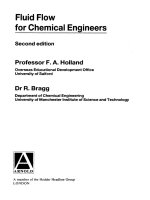Fluid therapy for acute bacterial meningitis
Bạn đang xem bản rút gọn của tài liệu. Xem và tải ngay bản đầy đủ của tài liệu tại đây (1.01 MB, 30 trang )
Fluid therapy for
acute bacterial
meningitis
Background
• Acute bacterial meningitis remains a disease
with high mortality and morbidity rates. Many
survivors sustain neurological deficits
• With prompt and adequate antimicrobial and
supportive treatment, the chances for survival
have improved
Background
• Careful management of fluid and electrolyte
balance is an important supportive therapy
• Both over- and under-hydration are
associated with adverse outcomes.
• There are potential risks from giving too
much fluid (especially brain swelling) as well
as too little fluid (especially shock).
Objectives
To evaluate treatment of acute bacterial
meningitis with differing volumes of initial
fluid administration (up to 72 hours after
first presentation) and the effects on death
and neurological sequelae.
Selection criteria
Randomised controlled trials (RCTs) of
differing volumes of fluid given in the initial
management of bacterial meningitis were
eligible for inclusion.
Data collection and analysis
• Three trials eligible for inclusion (415
children)
• All trials were set in countries where death
rates are high and where patients seek
help late
Trước đây
• Biến chứng hạ Natri máu
• Có thể do tăng nồng độ hormon chống bài
niệu – ADH
• Có sự liên quan giữa hạ Natri máu và co giật
+ bệnh trầm trọng hơn + di chứng thần kinh
• Có sự liên quan tới tỉ lệ tử vong cao do phù
não
Hạn chế dịch để tránh làm phù não và cải
thiện di chứng thần kinh
Trước đây
• Tỉ lệ tử vong cao còn ở những TH thiếu nước
• TH trẻ được duy trì lượng dịch cùng với
lượng dịch mất, nồng độ cao ADH về bình
thường sau 24h
• TH hạn chế dịch 2/3 nhu cầu, nồng độ ADH
vẫn cao
ADH tăng trong viêm màng não vi khuẩn do
giảm thể tích chỉ trở lại bình thường khi bù đủ
dịch và Natri
Methods
Types of participants : All age groups
with a diagnosis of acute bacterial
meningitis (by clinical diagnosis or culture
of cerebrospinal fluid)
Methods
Types of interventions :
• Fluid administered in the initial treatment of acute
bacterial meningitis; irrespective of route of
administration, type or volume of fluid.
• Comparisons of the initial volume of fluid administered
in the treatment of acute bacterial meningitis,
irrespective of route of administration, or type of fluid
or duration of fluid restriction.
Methods
Types of outcome measures
Primary outcomes
• Death
• Short-term (within the first four weeks of
illness) and long-term (persisting after the
first four weeks of illness) neurological
sequelae
Methods
Secondary outcomes
• Oedema (including cerebral)
• Total body water
• Extracellular water
• Serum and urinary sodium
• Plasma and urinary osmolality
Included studies
a) Volume and constitution of fluid
Duke 2002 compared milk-based fluids delivered at 60% of that
required for maintenance fluids with 100% of normal maintenance
fluids.
Maintenance fluids were defined : 100 ml/kg/day for the first 10 kg of
BW, 50 ml/kg for the second 10 kg, and 20 ml/kg for over 20 kg
The milk-based fluids comprised expressed breast milk or other milk
feed given via a nasogastric tube for at least 48 hours, or longer
with reduced conscious state, convulsions, impaired upper airway
reflexes or persistent respiratory distress.
Normal maintenance fluids of a solution : 0.45% NaCl and 5% dextrose
plus 10 mmol/L of KCl per litre were delivered intravenously for at
least the first 48 hours.
Included studies
Powell 1990 compared two-thirds of required
maintenance fluids with full maintenance
fluids, plus replacement fluids for any
estimated deficit over 24 hours
Maintenance fluids : 100 ml/kg for the first 10
kg of BW, plus 50 ml/kg for the next 10 kg (10
kg to 20 kg), plus 20 ml/kg for each kilogram
in excess of 20 kg").
Rehydration was begun by administering 10 or
15 ml/kg by rapid intravenous infusion.
Included studies
Singhi 1995 compared restricted fluids at 65% of the calculated
maintenance fluid requirement with maintenance fluid
requirements, both given intravenously.
Maintenance fluid : 110 ml/kg for first 10 kg, 50 ml/kg for next 10
kg and 25 ml/kg for subsequent weight
The restricted fluids comprised one-fifth normal saline in 5%
dextrose for 24 hours, followed by "a gradual liberalisation at
a rate of 10 ml/kg over eight hours, if, after 24 hours of
hospital stay, the serum sodium and plasma osmolality had
returned to normal and there were no clinical signs of
dehydration".
Included studies
b) Duration of fluid therapy
One study administered fluids for 48 hours (Duke 2002);
one study administered fluids for 24 hours (Powell
1990); and the third study administered fluid for 24
hours with a gradual increase thereafter until children
in both arms received the full normal maintenance
requirement after 48 hours (Singhi 1995).
Included studies
Baseline characteristics of participants
a) Age
Duke 2002 between 1 month and 12 years
Powell 1990 between three months and 16
years
Singhi 1995 between two months and 7
years
Included studies
b) Health status
• Duke 2002 : chidren were from a population in which
25% were undernourished at the time of their
presentation.
In regard to the meningitis symptoms, the mean
duration of symptoms was 6 days, with two-thirds of
children having convulsions, before presentation; 20%
of the children were hypoglycaemic.
• Powell 1990 : previously healthy children
• Singhi 1995 : Malnourished children were excluded
study and children had a duration of symptoms
ranging from one to 10 days on presentation.
Included studies
c) Diagnostic techniques used to establish a diagnosis of
bacterial meningitis
Duke 2002 : clinical signs of meningitis and a cloudy or
turbid cerebrospinal fluid (CSF) with a moderate or
large number of leucocytes and amount of protein,
determined by dipstick testing.
Powell 1990 : clinical examination, CSF cytology and
chemical studies.
Singhi 1995 : suggestive history, physical examination and
CSF findings of hypoglycorrhachia, increased protein
concentration and polymorphonuclear leucocytosis.
Main results
The meta-analysis found no significant
difference between the maintenance-fluid
and restricted-fluid groups in number of
deaths (RR 0.82, 95% confidence interval
(CI) 0.53 to 1.27; 407 participants)
(moderate trial quality)
Main results
The meta-analysis found no significant difference
between the maintenance-fluid and restricted-fluid
groups in acute severe neurological sequelae (RR
0.67, 95% CI 0.41 to 1.08; 407 participants) (very
low trial quality); or in mild to moderate sequelae
(RR 1.24, 95% CI 0.58 to 2.65; 357 participants)
(moderate trial quality)
Main results
When neurological sequelae were defined further,
there was a statistically significant difference in
favour of the maintenance-fluid group for spasticity
(RR 0.50, 95% CI 0.27 to 0.93; 357 participants);
seizures at both 72 hours (RR 0.59, 95% CI 0.42
to 0.83; 357 participants) and 14 days (RR 0.19,
95% CI 0.04 to 0.88; 357 participants)









